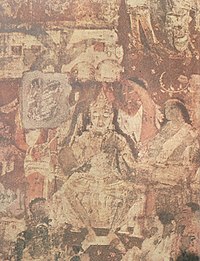| King of the Sinhalese Kingdom | |
|---|---|
| සිංහල ද්වීපයේ රජ | |
 Royal Standard of the King of Kandy in 1815 | |
 Vijaya | |
| Details | |
| First monarch | Vijaya |
| Last monarch | Sri Vikrama Rajasinha |
| Formation | 543 BC |
| Abolition | 2 March 1815 |
| Residence | Capital of Sri Lanka |
| Monarchical Sri Lanka | |
|---|---|
 | |
Part of a series on the politics and government of the Sinhala kingdom | |
| Monarch | King |
| Queen consort | Randolis |
Sub king / Heir apparent | Yuvaraja |
| Other queens | Rididoli |
| Wife or Concubinage | Yakadadoli |
| 1st Prime Minister | Pallegampahê Adikâram Mahatmayâ |
| 2nd Prime Minister | Udagampahê Adikâram Mahatmayâ |
| 3rd Prime Minister | Siyapattuwa Adikâram Mahatmayâ |
| Chief Secretary | Mahâ Mohottâla |
| Provincial Governors | Mahâ Dissâvas |
| Royal Household Officers | Dugganna Nilamês |
| Sons of Chiefs | Bandâras |
The Sinhalese monarchy (Sinhala සිංහල රාජාණ්ඩුව) has its origins in the settlement of North Indian Indo-Aryan immigrants to the island of Sri Lanka. The Landing of Vijay as described in the traditional chronicles of the island, the Dipavamsa, Mahavamsa and Culavamsa, and later chronicles, recount the date of the establishment of the first Sinhala Kingdom in 543 BC[note 1] when Prince Vijaya (543–505 BC), an Indian Prince, and 700 of his followers are claimed to have landed on the island of Sri Lanka and established the Kingdom of Tambapanni.[1][2] In Sinhalese mythology, Prince Vijaya and followers are told to be the progenitors of the Sinhalese people. However according to the story in the Divyavadana, the immigrants were probably not led by a scion of a royal house in India, as told in the romantic legend, but rather may have been groups of adventurous and pioneering merchants exploring new lands.[3]
The Sinhalese monarch was the head of state of the Sinhala Kingdom (Sri Lanka)[note 2]. Anachronistically referred to as the Kings of Sri Lanka,[note 3] the monarch held absolute power and succession was hereditary. The monarchy comprised the reigning monarch, his or her family, and the royal household which supports and facilitates the monarch in the exercise of his royal duties and prerogatives. The monarchy existed for over 2300 years. Tambapanni and its successive kingdoms were situated in what is presently Sri Lanka. The monarchy ended with Sri Vikrama Rajasinha of Kandy in 1815 after generations of European influences and upheaval in the royal court.
Cite error: There are <ref group=note> tags on this page, but the references will not show without a {{reflist|group=note}} template (see the help page).
- ^ Mittal (2006) p 405
- ^ "483 BC – Arrival of Aryans to Sri Lanka". scenicsrilanka.com. Retrieved 2009-11-06.
